Miniature Snakes in the Flower Garden
Work in your flower beds, dig in mulch or rich soil, lift or move stepping stones or other landscape structures, and you have your hands in the habitat of a number of our smallest snake species. The loose friable soil of the kept garden, and the shady moist conditions of some of its locations, provide a preferred habitat for these miniatures of the snake world (i.e. adult snakes that are typically less than 14 inches in length). These small creatures are adapted for living in the loose and penetrable leaf litter and rich topsoil found in natural hardwood forests. They likely find the conditions of a flower garden or an azalea bed very similar to what they seek in nature.
These are largely secretive species, ones that do not readily show themselves, and we only become aware of them while digging around in their habitat. Some spend much of their time under the ground, living (and looking) like large earthworms (worm snake). Some are colored like small gems with bright red or yellow bellies and neck rings (redbelly snake, ringneck snake), while others are drab earth colors (brown snake, smooth earth snake, crowned snake). These are all non-venomous species (*), and most will not offer to bite even if handled. A list of “miniature species” would include the following.
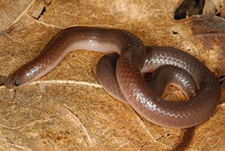 |
Worm Snake (Carphophis amoneus): like a worm with eyes and a tongue, 3 |
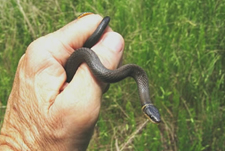 |
Ringneck Snake (Diadophis punctatus): slate gray on back and sides, bright yellow belly with dots, and yellow ring around its neck, 3 |
 |
Brown Snake (Storeria dekayi): brown/gray, two rows of small dots down its back, whitish belly, 3 |
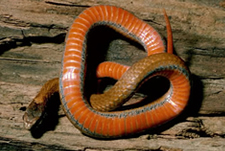 |
Redbelly Snake (Storeria occipitomaculata): brown/gray, with distinctly cinnamon to red colored belly, 3 |
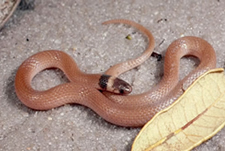 |
Southeastern Crowned Snake (Tantilla coronata): light tan, with dark head and dark collar, 1 |
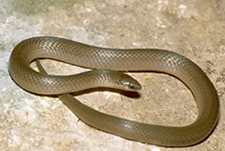 |
Smooth Earth Snake (Virginia valeriae): uniform gray or brown, 1 |
(*) – note: the Southeastern crowned snake has very small fangs in the rear of its mouth with which it can inject a toxin into its “insect” prey. It is not considered “venomous” to humans.
